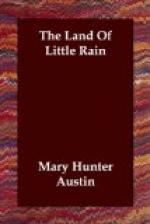Winnenap’, whose memory ran to the time when the boundary of the Paiute country was a dead-line to Shoshones, told me once how himself and another lad, in an unforgotten spring, discovered a nesting place of buzzards a bit of a way beyond the borders. And they two burned to rob those nests. Oh, for no purpose at all except as boys rob nests immemorially, for the fun of it, to have and handle and show to other lads as an exceeding treasure, and afterwards discard. So, not quite meaning to, but breathless with daring, they crept up a gully, across a sage brush flat and through a waste of boulders, to the rugged pines where their sharp eyes had made out the buzzards settling.
The medicine-man told me, always with a quaking relish at this point, that while they, grown bold by success, were still in the tree, they sighted a Paiute hunting party crossing between them and their own land. That was mid-morning, and all day on into the dark the boys crept and crawled and slid, from boulder to bush, and bush to boulder, in cactus scrub and on naked sand, always in a sweat of fear, until the dust caked in the nostrils and the breath sobbed in the body, around and away many a mile until they came to their own land again. And all the time Winnenap’ carried those buzzard’s eggs in the slack of his single buckskin garment! Young Shoshones are like young quail, knowing without teaching about feeding and hiding, and learning what civilized children never learn, to be still and to keep on being still, at the first hint of danger or strangeness.
As for food, that appears to be chiefly a matter of being willing. Desert Indians all eat chuck-wallas, big black and white lizards that have delicate white flesh savored like chicken. Both the Shoshones and the coyotes are fond of the flesh of Gopherus agassizii, the turtle that by feeding on buds, going without drink, and burrowing in the sand through the winter, contrives to live a known period of twenty-five years. It seems that most seeds are foodful in the arid regions, most berries edible, and many shrubs good for firewood with the sap in them. The mesquite bean, whether the screw or straight pod, pounded to a meal, boiled to a kind of mush, and dried in cakes, sulphur-colored and needing an axe to cut it, is an excellent food for long journeys. Fermented in water with wild honey and the honeycomb, it makes a pleasant, mildly intoxicating drink.
Next to spring, the best time to visit Shoshone Land is when the deer-star hangs low and white like a torch over the morning hills. Go up past Winnedumah and down Saline and up again to the rim of Mesquite Valley. Take no tent, but if you will, have an Indian build you a wickiup, willows planted in a circle, drawn over to an arch, and bound cunningly with withes, all the leaves on, and chinks to count the stars through. But there was never any but Winnenap’ who could tell and make it worth telling about Shoshone Land.




